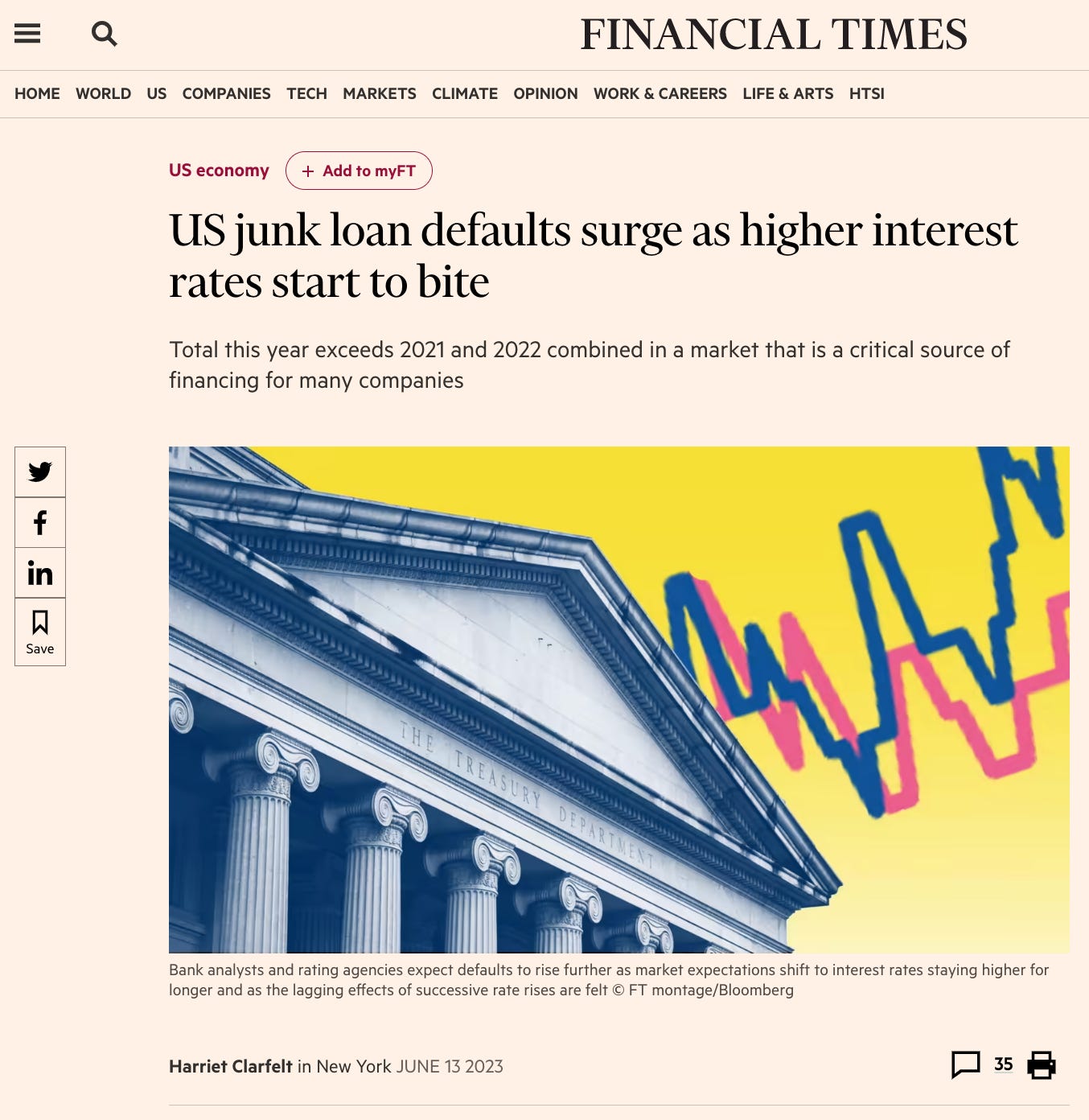US junk bonds and defaults (20Jun2023)
News about Junk Bond
Extract from News Article:
Defaults in the $1.4tn US junk loan market have climbed sharply this year as the Federal Reserve’s aggressive campaign of interest rate rises increases the pressure on risky companies with “floating” borrowing costs. There were 18 debt defaults in the US loan market between January 1 and the end of May totalling $21bn — greater in number and total value than for the whole of 2021 and 2022 combined, according to a Goldman Sachs analysis of data from PitchBook LCD.
My investing Muse
US high-yield bonds (typically junk bonds)
(Source of chart)
High-yield bonds, also known as junk bonds, are bonds with lower credit ratings and usually present high default risks. Junk bonds are typically those with BBB ratings and lower, including BB, B, and CCC grades. Rising yields on junk bonds indicate that investors are dubious about these companies' solvency.
The increasing number of junk bond defaults can be seen as more businesses going under. Between January to May 2023, we have more defaults (in number & amount) than 2021 & 2022 combined. We can probably expect more in the rest of 2023. Personally, this can be a good barometer of the health of the economy. Does more default imply the quickening of a recession?
$21 billion has been lost. Will this lead to more exit from junk bonds market? How will this direct the flow of capital in the market?
At this point, this is not good news for the macro and let us continue to monitor with caution.
The following is research provided by Google Bard about Junk Bonds.
What is a junk bond?
A junk bond is a type of bond that is considered to be high-risk. This means that the issuer of the bond is more likely to default on its payments than a bond with a higher credit rating. Junk bonds typically have a yield that is higher than investment-grade bonds to compensate investors for the increased risk.
The current state of the US junk bond market
The US junk bond market has been on a tear in recent years. The yield on the Bloomberg Barclays US High Yield Index has fallen from over 10% in 2016 to around 5% today. This is due to several factors, including low-interest rates, strong economic growth, and a favourable regulatory environment.
What does the future hold for the US junk bond market?
It is difficult to say what the future holds for the US junk bond market. However, there are some factors that could contribute to a slowdown in the market, such as rising interest rates, a recession, or a change in the regulatory environment.
Overall, the US junk bond market is currently in a strong position. However, investors should be aware of the risks involved before investing in these securities.
Here are some additional factors to consider when investing in junk bonds:
The credit rating of the issuer: The credit rating of the issuer is the most important factor to consider when investing in junk bonds. A higher credit rating indicates a lower risk of default.
The yield: The yield on a junk bond is the amount of interest that the issuer will pay to investors. The yield is typically higher than the yield on investment-grade bonds to compensate investors for the increased risk.
The maturity date: The maturity date is the date on which the issuer will repay the principal to investors. Junk bonds typically have a shorter maturity date than investment-grade bonds.
Liquidity: The liquidity of a junk bond is the ease with which it can be bought or sold. Junk bonds are typically less liquid than investment-grade bonds. If you are considering investing in junk bonds, it is important to do your research and understand the risks involved.
As you can see, the size of the junk bond market has been growing in recent years. However, the default amount has been relatively stable. This is because the junk bond market is cyclical, and defaults tend to increase during times of economic recession.
It is important to note that these are just the aggregate numbers for the US junk bond market. The default amount for individual bonds can vary significantly. For example, the default amount for the infamous junk bond issuer Energy Future Holdings was $43 billion in 2014.
If you are considering investing in junk bonds, it is important to do your research and understand the risks involved. Junk bonds are a high-risk investment, and there is a risk of default. However, they can also offer high yields if the issuer does not default.


Comments
Post a Comment